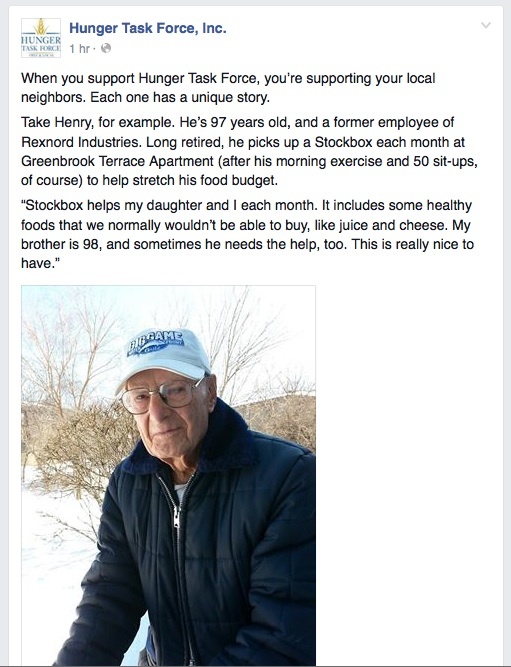“Nobody really goes hungry in America.”
“People should just get a job. Then they could feed their family.”
And the misconceptions about hunger go on and on.
Milwaukee-based Hunger Task Force has been feeding the hungry – and fighting future hunger – since 1974. They attack the issue of hunger on two fronts: Advocacy and Food Banking. Both require the generosity of donors to help them do their work.
As with any non-profit, it is critical to build a clear and compelling case to explain what your organization does, why it is important and why people should support you.
While it’s important to show impact and need, too often non-profits stop at the numbers.
Not Hunger Task Force. They do a brilliant job of putting a “face to the case.” They walk a fine balance between telling a person’s story with dignity and respect, while showing who needs – and benefits from – their work.
This was a post on their Facebook page this week:

Not the face of hunger you were expecting?
Or take this short video from a few years ago, illustrating the need – both financial and legislative – to ensure children are fed during the summer.
Executive Director, Sherrie Tussler, says, “For years I’ve tried to explain the inadequacies and inequities that exist for Milwaukee’s poorest children, but no matter how many charts, maps or words I put to it – few seem motivated enough to make the necessary changes to ensure that these children are fed healthy meals in the summer.
SO – I invite you to see for yourself. We brought a camera so you can see what I see. Kids being fed on a street corner. Toddlers standing in line looking for help. Older kids pushing to be served first in case the van runs out of food.”
And the video goes on to illustrate the need, the roadblocks and possible solutions. All the while, we see dozens of children in line, getting what is likely their only meal of the day from the back of a van.
Hard to imagine the donor who wouldn’t be compelled to support this cause.
Think about who you serve. Who are the faces – the real people – that benefit from your critical work? When you tell their story and bring your case for support to life, keep this tried-and-true Donor By Design storytelling structure in mind:
- Set the stage/context
- Who is the person?
- What is the problem?
- How has the situation improved?
- What did your organization do to help?
How does this story represent the greater impact of your organization?
The stories are there. The donors are there. How can you put a face to your case and connect the two?
(Author’s note: I had the pleasure of working for Hunger Task Force about 12 years ago and continue to follow – and admire – the tremendous work they are doing on behalf of Milwaukee’s poorest citizens.)

